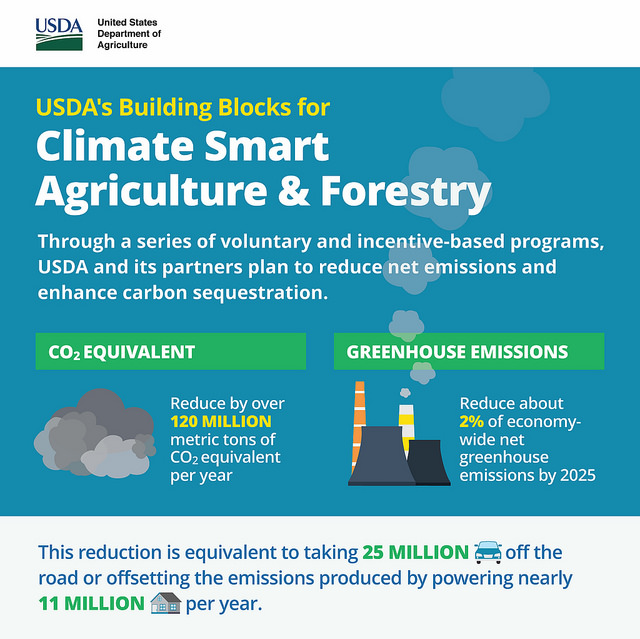As the impacts of climate change become more extreme, resilient agriculture systems are critical to maintaining economic, ecological, and community health. In the face of such uncertainty, we must prioritize the establishment of food production systems that are diverse and flexible enough to deal with a changing climate.
On May 12, 2016, U.S. Department of Agriculture (USDA) Secretary Tom Vilsack announced the targeted allocation of $72.3 million for conservation practices, including those that promote soil health and carbon storage. The funding will be delivered through the Natural Resources Conservation Service’s (NRCS) Environmental Quality Incentives Program (EQIP) during the current fiscal year, and will support conservation practices that advance the agency’s Building Blocks for Climate Smart Agriculture. The new funding represents dollars carried forward from the previous fiscal year.
USDA also released a new report that catalogues the agency’s progress on climate change responsiveness over the past year, and provides details on their framework for helping farmers, ranchers, and forestland owners in their efforts to mitigate and respond to climate change.
During the announcement, Secretary Vilsack highlighted the critical role American farmers, ranchers, and forestland owners have played in mitigating the negative effects of climate change:
“American farmers, ranchers, and forestland owners are global leaders in conserving rural America’s natural resources and reducing greenhouse gas emissions,” said Vilsack. “With today’s announcement, USDA is providing the necessary tools and resources called for under the President’s Climate Action Plan so producers and landowners can successfully create economic opportunity and provide the food, fiber, and energy needs of a growing global population.”
The National Sustainable Agriculture Coalition (NSAC) has continuously encouraged USDA to harness the enormous potential of working lands conservation programs for their ability to support climate change mitigation efforts, and we applaud the agency for making this important investment in soil health and carbon storage efforts through EQIP.
In fiscal year (FY) 2016, the Building Blocks report estimates that NRCS will invest approximately $300 million in practices that have climate change benefits through EQIP; a total of $1.4 billion since 2009. These practices include those that improve soil health and sequester carbon – such as conservation cover, conservation crop rotation, cover crops, prescribed grazing, and forage planting – as well as those that improve nutrient management and limit nitrogen emissions.
Absent in today’s announcement and report, however, was mention of the Conservation Stewardship Program (CSP). Through CSP, the largest USDA conservation program, farmers and ranchers have implemented a wide range of conservation enhancements and practices that address climate change through comprehensive conservation efforts. These conservation methods are an important part of any climate change conversation because they include more advanced cover cropping, crop rotation, and nutrient management activities then those provided through EQIP. NSAC looks forward to working with USDA on the upcoming planned overhaul of CSP, which will provide additional opportunities to incentivize, reward, and bundle CSP conservation practices in a way that leverages the program’s enormous climate change mitigation potential.
USDA Climate Month Opportunities in 2016
Today’s climate announcement comes in the middle of USDA’s “Climate Month”, during which the agency is devoting their blog and other communications resources toward examining what a changing climate means to agriculture, and how USDA is working to reduce greenhouse gases. NSAC supports USDA’s focus on climate change and will continue to help them promote agricultural systems that mitigate climate change by sharing examples of farmers and ranchers across the country that are currently utilizing farm bill conservation support to sequester carbon, build soil health, and reduce greenhouse gas emissions.
Late last year, NSAC and Breakthrough Strategies and Solutions, LLC, jointly published a paper that explores how soil carbon is sequestered, the state of soil carbon research, and the debate on its potential. It offers a set of recommendations for ongoing research and highlights the many co-benefits of increasing soil carbon. NSAC also reported on the top ten opportunities for USDA to act on climate change in 2016, including improved support for cover crops, resource-conserving crop rotation, organic transition, and management intensive grazing.
We believe that the time is ripe for the Administration to take the Building Blocks programs and initiatives even further by tapping the enormous potential of farmers and ranchers to help mitigate climate change. The climate-mitigation efforts we have proposed would require no new legislative authority to implement. We hope USDA will take up these proposals as they lead in partnering with our nation’s farmers and ranchers to create a lasting, positive climate legacy.



It is a miracle to see the USDA support Regenerative Agriculture concepts to sequester atmospheric carbon into soil. Do they really understand this is the missing half of the solution to combat climate change?